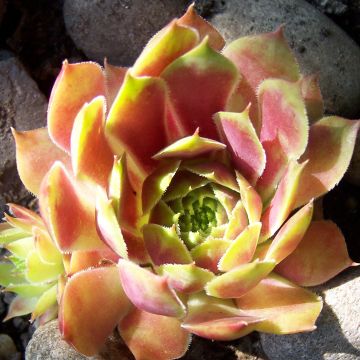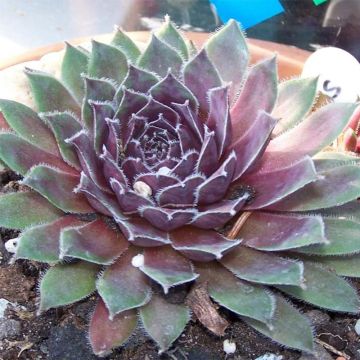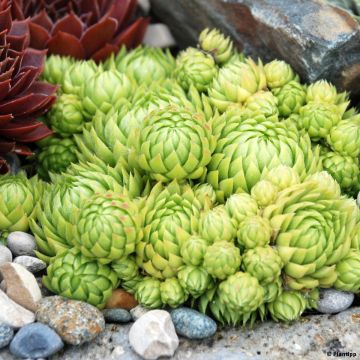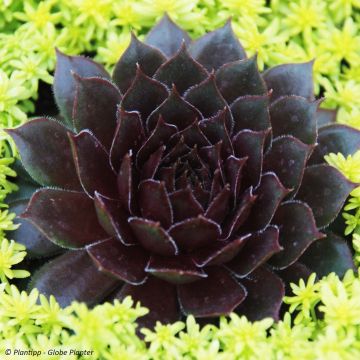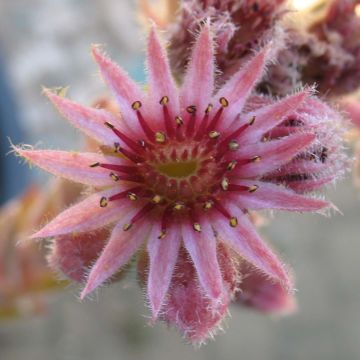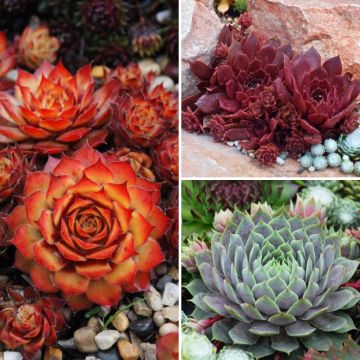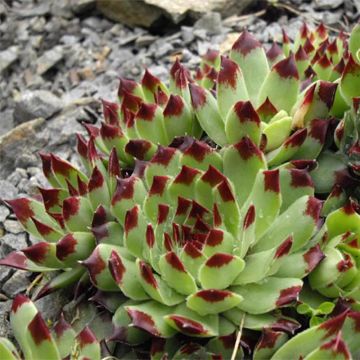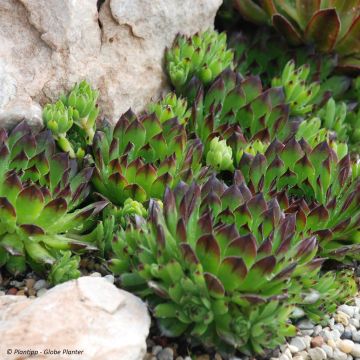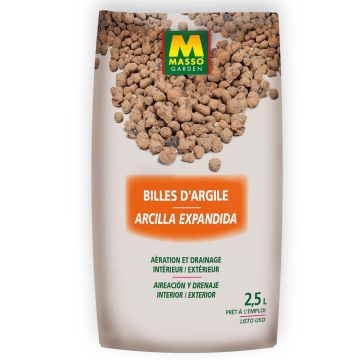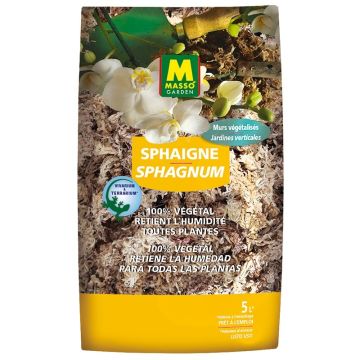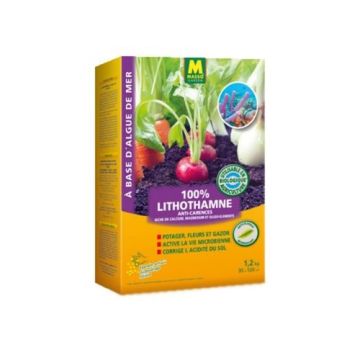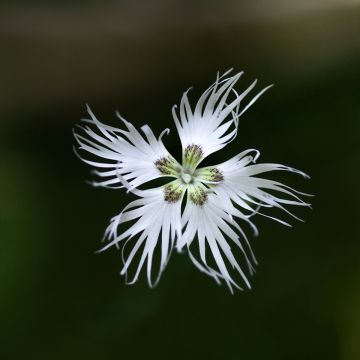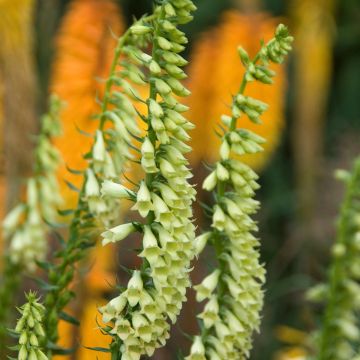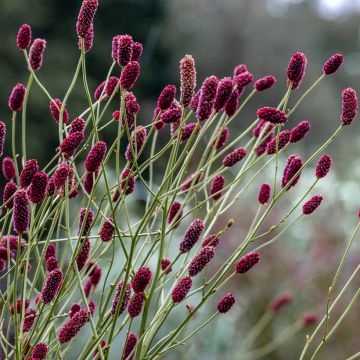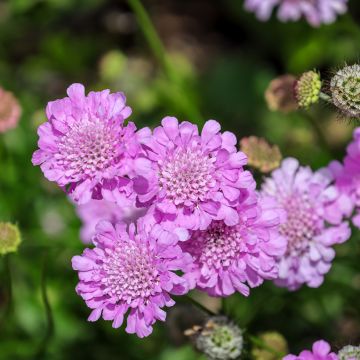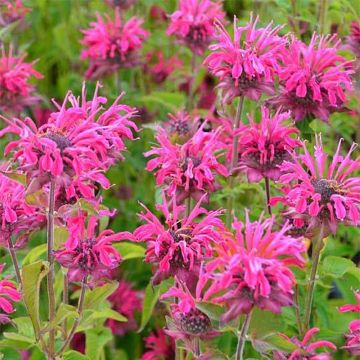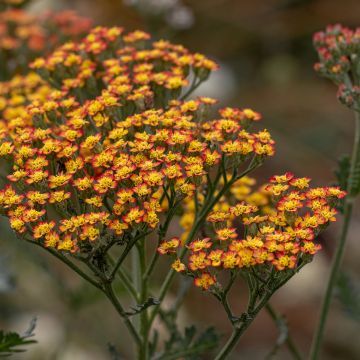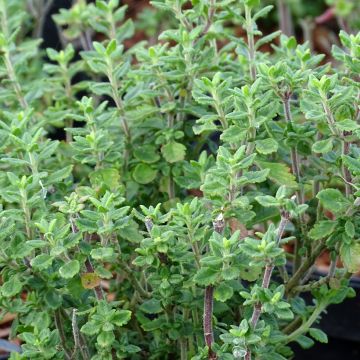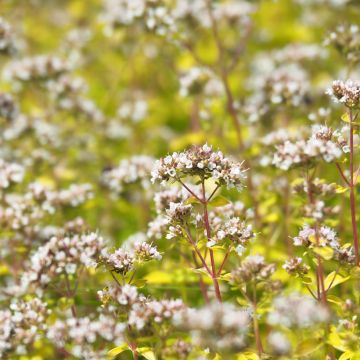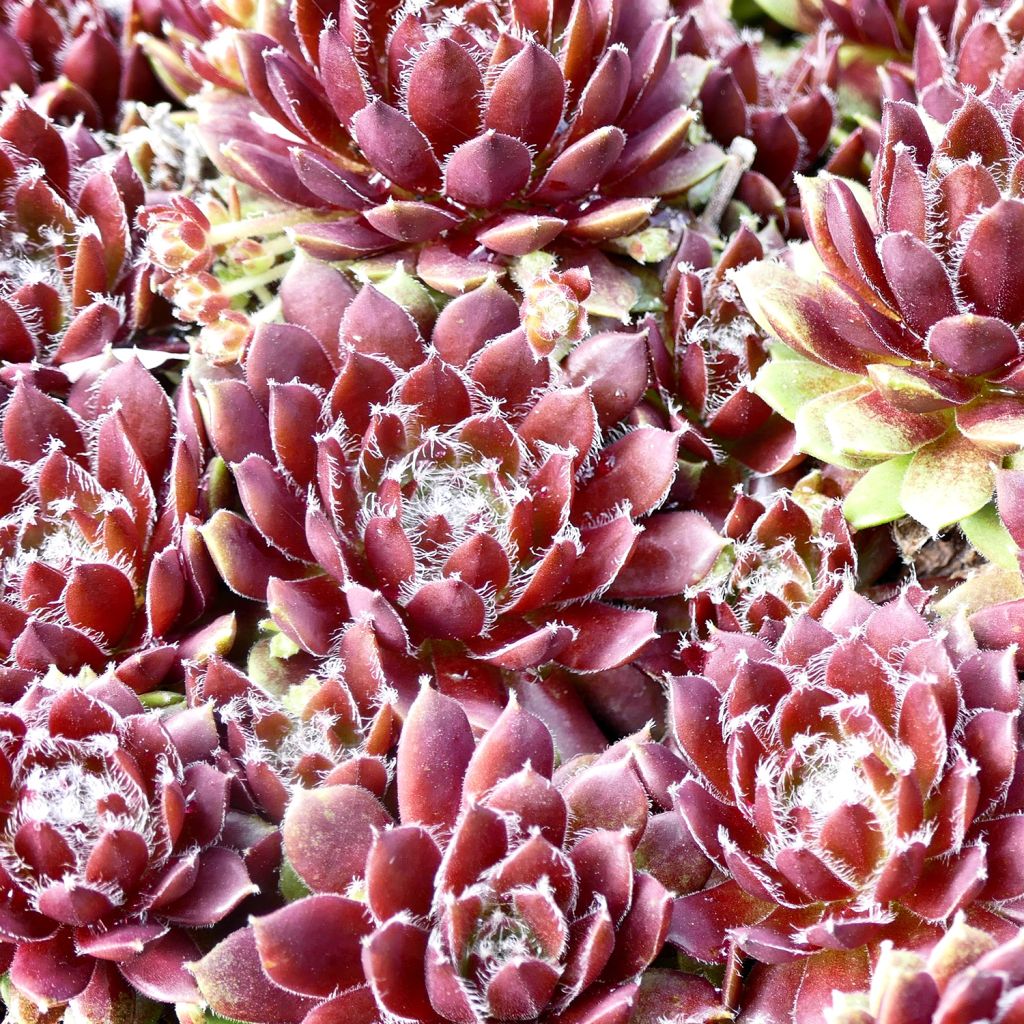

Sempervivum Silberkarneol - Joubarbe hybride rouge-rose.
Sempervivum Silberkarneol
Sempervivum Silberkarneol
Houseleek, Hen and Chicks
This item cannot be shipped to the selected country
Delivery charge from €5.90
More information
Schedule delivery date,
and select date in basket
This plant carries a 12 months recovery warranty
More information
We guarantee the quality of our plants for a full growing cycle, and will replace at our expense any plant that fails to recover under normal climatic and planting conditions.
From €5.90 for pickup delivery and €6.90 for home delivery
Express home delivery from €8.90.
Does this plant fit my garden?
Set up your Plantfit profile →
Description
Sempervivum 'Silberkarneol' is a sculptural hybrid variety of houseleek. It produces medium-sized, very tight rosettes, similar to pretty cabbages with fleshy, red-pink leaves, emerald green at the base, bordered and covered with silver bristles that catch the light. It has bright pink star-shaped flowers with a red centre in the heart of mature rosettes in summer. This succulent and colourful perennial will cover neglected, rocky or dry areas well. It requires no maintenance, only dry, poor, sandy or limestone soil, and will not need watering.
Sempervivum 'Silberkarneol' comes from the Arachnoid Houseleek (Sempervivum arachnoideum), a botanical species widespread in mountains. This wild Sempervivum can vary in appearance and lives on rocks or scree. 'Silberkarneol' clings to the smallest cracks to slowly form small colonies of rosettes of different sizes not more than 10 cm (4in) high. With time, it can form a dense carpet spreading over 60 cm (24in) on the ground. Each rosette resembles a small artichoke with a diameter of 3 cm (1in) to 5 cm (2in) with a nest of silver bristles composed of numerous pointed leaves tightly packed against each other in its centre. The plant is green in winter and quickly takes on a pink-red hue in spring and red-brown in summer, while retaining long hairs along the edge of each leaf that catch the sun. Rosettes aged 2 or 3 years will produce 1-5 star-shaped flowers in summer and then disappear, after producing several small rosettes on the periphery. 1 to 5 star-shaped flowers form on thick stems, with 8-10 purple-pink petals and a dark red centre.
Silberkarneol Sempervivum is a gift for rocky gardens with thin soil where few species. If your soil is poor, rather dry, stony, rocky, or even slightly chalky, this easy to grow, hardy perennial (which withstands temperatures below -15°C (5°F)) will enliven any pile of stones, a wall, or even a green roof. Houseleeks are easy succulent plants, with various shades of flowers and foliage allowing for astonishing compositions. Perfect in pots and irreplaceable in borders, troughs, or rockeries, alongside London pride (Saxifraga umbrosa), wall bellflowers, or Lewisia cotyledon, you will want to collect more of these miniature perennials. Consider companions with staggered flowering (Sedums, thymes) and colourful foliage (Bergenia, Euphorbia myrsinites...) for an interesting and variegated rockery.
Report an error about the product description
Sempervivum Silberkarneol in pictures
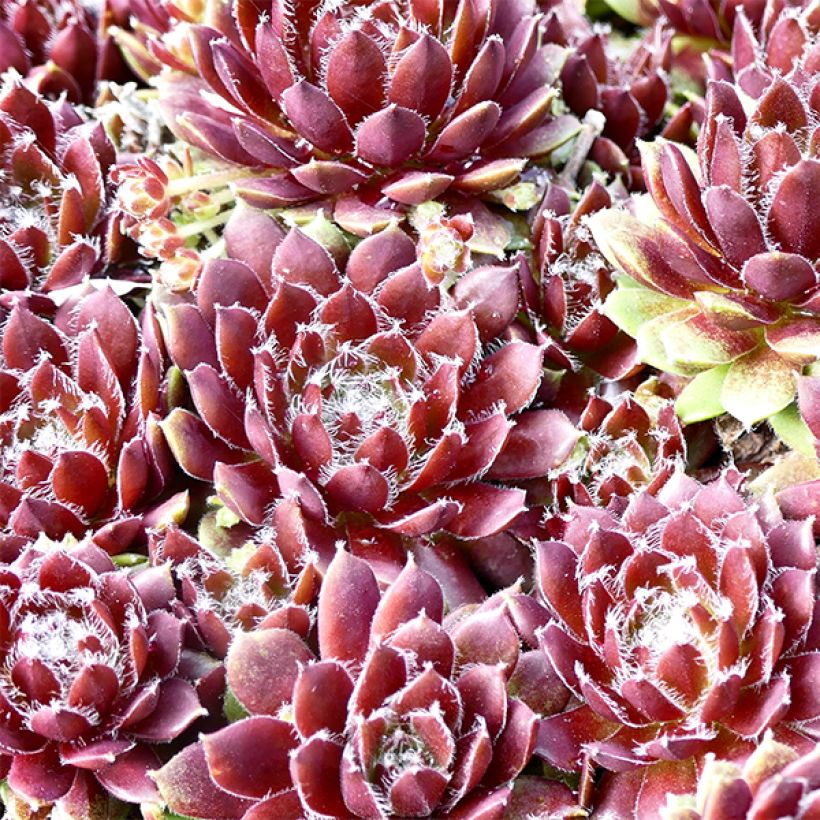

Flowering
Foliage
Plant habit
Botanical data
Sempervivum
Silberkarneol
Crassulaceae
Houseleek, Hen and Chicks
Cultivar or hybrid
Other Sempervivum - Houseleek
Planting and care
Sempervivum Silberkarneol likes sunny or semi-shaded exposures and well-drained, moist to dry and poor, sandy or gravelly soils. Plant in spring or autumn, in the ground or a container, adding gravel or coarse sand to the substrate. If you plant it in a rockery or on a wall, just give it a little soil to allow it to establish.
If you want to multiply it, simply cut a few young rosettes and replant them elsewhere, just burying the roots. Make sure it is not overwhelmed by taller plants or covered with dead leaves or vegetation and remove faded inflorescences.
Planting period
Intended location
Care
-
, onOrder confirmed
Reply from on Promesse de fleurs
Summer flowering perennials
Haven't found what you were looking for?
Hardiness is the lowest winter temperature a plant can endure without suffering serious damage or even dying. However, hardiness is affected by location (a sheltered area, such as a patio), protection (winter cover) and soil type (hardiness is improved by well-drained soil).

Photo Sharing Terms & Conditions
In order to encourage gardeners to interact and share their experiences, Promesse de fleurs offers various media enabling content to be uploaded onto its Site - in particular via the ‘Photo sharing’ module.
The User agrees to refrain from:
- Posting any content that is illegal, prejudicial, insulting, racist, inciteful to hatred, revisionist, contrary to public decency, that infringes on privacy or on the privacy rights of third parties, in particular the publicity rights of persons and goods, intellectual property rights, or the right to privacy.
- Submitting content on behalf of a third party;
- Impersonate the identity of a third party and/or publish any personal information about a third party;
In general, the User undertakes to refrain from any unethical behaviour.
All Content (in particular text, comments, files, images, photos, videos, creative works, etc.), which may be subject to property or intellectual property rights, image or other private rights, shall remain the property of the User, subject to the limited rights granted by the terms of the licence granted by Promesse de fleurs as stated below. Users are at liberty to publish or not to publish such Content on the Site, notably via the ‘Photo Sharing’ facility, and accept that this Content shall be made public and freely accessible, notably on the Internet.
Users further acknowledge, undertake to have ,and guarantee that they hold all necessary rights and permissions to publish such material on the Site, in particular with regard to the legislation in force pertaining to any privacy, property, intellectual property, image, or contractual rights, or rights of any other nature. By publishing such Content on the Site, Users acknowledge accepting full liability as publishers of the Content within the meaning of the law, and grant Promesse de fleurs, free of charge, an inclusive, worldwide licence for the said Content for the entire duration of its publication, including all reproduction, representation, up/downloading, displaying, performing, transmission, and storage rights.
Users also grant permission for their name to be linked to the Content and accept that this link may not always be made available.
By engaging in posting material, Users consent to their Content becoming automatically accessible on the Internet, in particular on other sites and/or blogs and/or web pages of the Promesse de fleurs site, including in particular social pages and the Promesse de fleurs catalogue.
Users may secure the removal of entrusted content free of charge by issuing a simple request via our contact form.
The flowering period indicated on our website applies to countries and regions located in USDA zone 8 (France, the United Kingdom, Ireland, the Netherlands, etc.)
It will vary according to where you live:
- In zones 9 to 10 (Italy, Spain, Greece, etc.), flowering will occur about 2 to 4 weeks earlier.
- In zones 6 to 7 (Germany, Poland, Slovenia, and lower mountainous regions), flowering will be delayed by 2 to 3 weeks.
- In zone 5 (Central Europe, Scandinavia), blooming will be delayed by 3 to 5 weeks.
In temperate climates, pruning of spring-flowering shrubs (forsythia, spireas, etc.) should be done just after flowering.
Pruning of summer-flowering shrubs (Indian Lilac, Perovskia, etc.) can be done in winter or spring.
In cold regions as well as with frost-sensitive plants, avoid pruning too early when severe frosts may still occur.
The planting period indicated on our website applies to countries and regions located in USDA zone 8 (France, United Kingdom, Ireland, Netherlands).
It will vary according to where you live:
- In Mediterranean zones (Marseille, Madrid, Milan, etc.), autumn and winter are the best planting periods.
- In continental zones (Strasbourg, Munich, Vienna, etc.), delay planting by 2 to 3 weeks in spring and bring it forward by 2 to 4 weeks in autumn.
- In mountainous regions (the Alps, Pyrenees, Carpathians, etc.), it is best to plant in late spring (May-June) or late summer (August-September).
The harvesting period indicated on our website applies to countries and regions in USDA zone 8 (France, England, Ireland, the Netherlands).
In colder areas (Scandinavia, Poland, Austria...) fruit and vegetable harvests are likely to be delayed by 3-4 weeks.
In warmer areas (Italy, Spain, Greece, etc.), harvesting will probably take place earlier, depending on weather conditions.
The sowing periods indicated on our website apply to countries and regions within USDA Zone 8 (France, UK, Ireland, Netherlands).
In colder areas (Scandinavia, Poland, Austria...), delay any outdoor sowing by 3-4 weeks, or sow under glass.
In warmer climes (Italy, Spain, Greece, etc.), bring outdoor sowing forward by a few weeks.

































